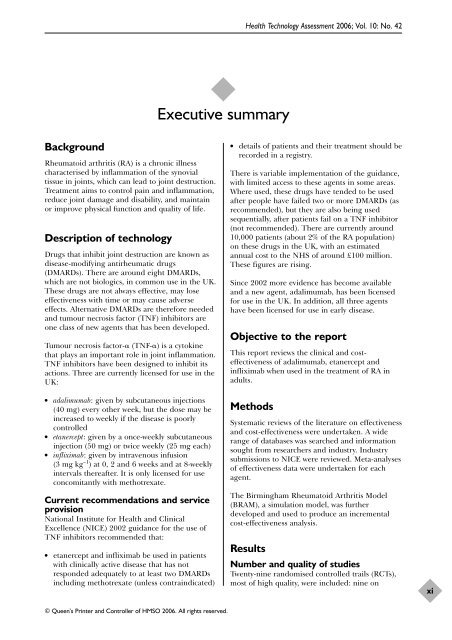A systematic review of the effectiveness of adalimumab
A systematic review of the effectiveness of adalimumab
A systematic review of the effectiveness of adalimumab
You also want an ePaper? Increase the reach of your titles
YUMPU automatically turns print PDFs into web optimized ePapers that Google loves.
Background<br />
Rheumatoid arthritis (RA) is a chronic illness<br />
characterised by inflammation <strong>of</strong> <strong>the</strong> synovial<br />
tissue in joints, which can lead to joint destruction.<br />
Treatment aims to control pain and inflammation,<br />
reduce joint damage and disability, and maintain<br />
or improve physical function and quality <strong>of</strong> life.<br />
Description <strong>of</strong> technology<br />
Drugs that inhibit joint destruction are known as<br />
disease-modifying antirheumatic drugs<br />
(DMARDs). There are around eight DMARDs,<br />
which are not biologics, in common use in <strong>the</strong> UK.<br />
These drugs are not always effective, may lose<br />
<strong>effectiveness</strong> with time or may cause adverse<br />
effects. Alternative DMARDs are <strong>the</strong>refore needed<br />
and tumour necrosis factor (TNF) inhibitors are<br />
one class <strong>of</strong> new agents that has been developed.<br />
Tumour necrosis factor- (TNF-) is a cytokine<br />
that plays an important role in joint inflammation.<br />
TNF inhibitors have been designed to inhibit its<br />
actions. Three are currently licensed for use in <strong>the</strong><br />
UK:<br />
● <strong>adalimumab</strong>: given by subcutaneous injections<br />
(40 mg) every o<strong>the</strong>r week, but <strong>the</strong> dose may be<br />
increased to weekly if <strong>the</strong> disease is poorly<br />
controlled<br />
● etanercept: given by a once-weekly subcutaneous<br />
injection (50 mg) or twice weekly (25 mg each)<br />
● infliximab: given by intravenous infusion<br />
(3 mg kg –1 ) at 0, 2 and 6 weeks and at 8-weekly<br />
intervals <strong>the</strong>reafter. It is only licensed for use<br />
concomitantly with methotrexate.<br />
Current recommendations and service<br />
provision<br />
National Institute for Health and Clinical<br />
Excellence (NICE) 2002 guidance for <strong>the</strong> use <strong>of</strong><br />
TNF inhibitors recommended that:<br />
● etanercept and infliximab be used in patients<br />
with clinically active disease that has not<br />
responded adequately to at least two DMARDs<br />
including methotrexate (unless contraindicated)<br />
Executive summary<br />
© Queen’s Printer and Controller <strong>of</strong> HMSO 2006. All rights reserved.<br />
Health Technology Assessment 2006; Vol. 10: No. 42<br />
● details <strong>of</strong> patients and <strong>the</strong>ir treatment should be<br />
recorded in a registry.<br />
There is variable implementation <strong>of</strong> <strong>the</strong> guidance,<br />
with limited access to <strong>the</strong>se agents in some areas.<br />
Where used, <strong>the</strong>se drugs have tended to be used<br />
after people have failed two or more DMARDs (as<br />
recommended), but <strong>the</strong>y are also being used<br />
sequentially, after patients fail on a TNF inhibitor<br />
(not recommended). There are currently around<br />
10,000 patients (about 2% <strong>of</strong> <strong>the</strong> RA population)<br />
on <strong>the</strong>se drugs in <strong>the</strong> UK, with an estimated<br />
annual cost to <strong>the</strong> NHS <strong>of</strong> around £100 million.<br />
These figures are rising.<br />
Since 2002 more evidence has become available<br />
and a new agent, <strong>adalimumab</strong>, has been licensed<br />
for use in <strong>the</strong> UK. In addition, all three agents<br />
have been licensed for use in early disease.<br />
Objective to <strong>the</strong> report<br />
This report <strong>review</strong>s <strong>the</strong> clinical and cost<strong>effectiveness</strong><br />
<strong>of</strong> <strong>adalimumab</strong>, etanercept and<br />
infliximab when used in <strong>the</strong> treatment <strong>of</strong> RA in<br />
adults.<br />
Methods<br />
Systematic <strong>review</strong>s <strong>of</strong> <strong>the</strong> literature on <strong>effectiveness</strong><br />
and cost-<strong>effectiveness</strong> were undertaken. A wide<br />
range <strong>of</strong> databases was searched and information<br />
sought from researchers and industry. Industry<br />
submissions to NICE were <strong>review</strong>ed. Meta-analyses<br />
<strong>of</strong> <strong>effectiveness</strong> data were undertaken for each<br />
agent.<br />
The Birmingham Rheumatoid Arthritis Model<br />
(BRAM), a simulation model, was fur<strong>the</strong>r<br />
developed and used to produce an incremental<br />
cost-<strong>effectiveness</strong> analysis.<br />
Results<br />
Number and quality <strong>of</strong> studies<br />
Twenty-nine randomised controlled trails (RCTs),<br />
most <strong>of</strong> high quality, were included: nine on<br />
xi
















